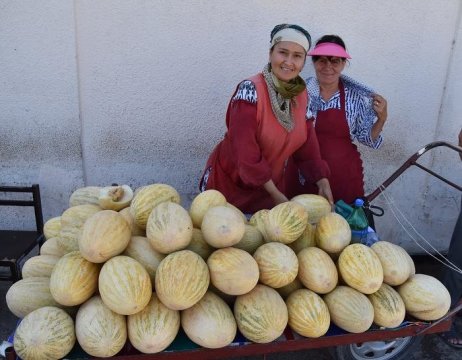[ad_1]
Studies of ancient preserved plant remains from a medieval archaeological site in the Pamir Mountains of Uzbekistan have shown that fruits, such as apples, peaches, apricots, and melons, were cultivated in the foothills of Inner Asia. The archaeobotanical study, conducted by Robert Spengler of the Max Planck Institute for the Science of Human History, is among the first systematic analyses of medieval agricultural crops in the heart of the ancient Silk Road. Spengler identified a rich assemblage of fruit and nut crops, showing that many of the crops we are all familiar with today were cultivated along the ancient trade routes.
The Silk Road was the largest vector for cultural spread in the ancient world — the routes of exchange and dispersal across Eurasia connected Central Asia to the rest of the world. These exchange routes functioned more like the spokes of a wagon wheel than a long-distance road, placing Central Asia at the heart of the ancient world. However, most historical discussions of the ancient Silk Road focus on the presence of East Asian goods in the Mediterranean or vice versa. The present study, published in PLOS ONE, looks at archaeological sites at the center of the trans-Eurasian exchange routes during the medieval period, when cultural exchange was at its highest. Additionally, scholarship has focused on a select handful of goods that moved along these trade routes, notably silk, metal, glass, and pastoral products. However, historical sources and now archaeological data demonstrate that agricultural goods were an important commodity as well. Notably, higher value goods, such as fruits and nuts, spread along these exchange routes and likely contributed to their popularity in cuisines across Europe, Asia, and North Africa today. Ultimately this study helps demonstrate how the Silk Road shaped what foods we all eat today.
Our everyday fruits and nuts have their roots in the Silk Road
Spengler analyzed preserved ancient seeds and plant parts recovered from a medieval archaeological site in the foothills of the Pamir Mountains of eastern Uzbekistan. The site, Tashbulak, is currently under excavation by a collaborative international Uzbek/American project co-directed by Michael Frachetti, of Washington University in St. Louis, and Farhod Maksudov, of the Institute for Archaeological Research, Academy of Sciences in Tashkent, Uzbekistan. The plant remains recovered from this site represent one of the first systematic studies of the crops that people were growing along the Silk Road. In the article, archaeobotanical data are contrasted with historical and other archaeological evidence in order to discuss the timing and routes of spread for the cultivated plants. These plant remains date to roughly a millennium ago and include apple, grape, and melon seeds, peach and apricot pits, and walnut and pistachio shells.
This study helps demonstrate that there was a rich and diverse economy in Central Asia during this period, including a wide array of cultivated grains, legumes, fruits, and nuts. The site of Tashbulak is located at 2100 meters above sea level, above the maximum elevations at which many of these fruit trees can be grown, suggesting that the fruit remains recovered at the site were carried from lower elevations. Historical sources attest to the importance of fresh and dried fruits and nuts as a source of commerce at market bazaars across Inner Asia. These trade routes facilitated the spread of many of our most familiar crops across the ancient world. For example, the earliest clear archaeological evidence for peaches and apricots comes from eastern China, but they were present in the Mediterranean by the Classical period. Likewise, grapes originated somewhere in the broader Mediterranean region, but grape wine was a popular drink in the Tang Dynasty. We can now say that all of these fruit crops were prominent in Central Asia by at least a millennium ago, likely much earlier. As Spengler points out, “The ecologically rich mountain valleys of Inner Asia fostered the spread of many cultivated plants over the past five millennia and, in doing so, shaped the ingredients in kitchens across Europe and Asia.”
Central Asia is a key homeland and dispersal point for many important arboreal crops, such as apples and pistachios
Spengler also points out that many economically important fruit crops originated in the foothill forests of eastern Central Asia. For example, studies suggest that much of the genetic material for our modern apples comes from the Tien Shan wild apples of southeastern Kazakhstan, and pistachios originated in southern Central Asia. Despite the importance of these arboreal crops in the modern world economy, relatively limited scholarly focus has gone into the study of their origins and dispersal. The data from Tashbulak are an important contribution to that study. The article shows the importance of archaeological research in Central Asia, highlighting its role in the development of cultures across the ancient world.
In his forthcoming book, “Fruit from the Sands,” Spengler traces the spread of domesticated plants across Central Asia. In the book, set to hit shelves in April 2019, he states, “The plants in our kitchens today are archaeological artifacts, and part of the narrative for several of our favorite fruits and nuts starts on the ancient Silk Road.”
Excavations at Tashbulak are ongoing, with support from Washington University in St. Louis, the Max von Berchem Foundation, and the National Geographic Society. Over the next few years, the research team expects that their research will better elucidate the nature of interaction and contact in the mountains of Central Asia. Frachetti notes, “The insights gained from this archaeobotanical study help link the juicy details of ancient cuisine to our modern tables, and in doing so highlights the long-term impact of interactions between diverse communities and regions on a global scale.”
[ad_2]















